mobile Ansicht, to the English Version tap the flag
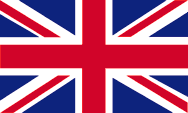

- Republik Trinidad und Tobago
- parlamentarische Republik
- bestehend aus den Inseln Trinidad und Tobago
- Eigenbezeichnung: Republic of Trinidad and Tobago
• Flaggen
• historische Flaggen
• Bedeutung/Ursprung der Flagge
• Wappen
• Bedeutung/Ursprung des Wappens
• Flugzeugkokarde
• Landkarte
• Zahlen und Fakten
• Geschichte
• Ursprung des Landesnamens
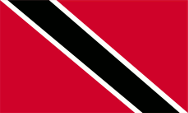
seit 1962,
National- und Staatsflagge,
Seitenverhältnis = 3:5,
Quelle, nach: Flags of the World





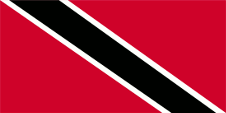
Handelsflagge und Staatsflagge zur See,
Seitenverhältnis = 1:2,
Quelle, nach: Flags of the World



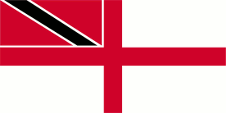
Marineflagge,
Seitenverhältnis = 1:2,
Quelle, nach: Flags of the World



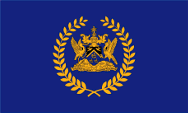
Flagge des Präsidenten,
Seitenverhältnis = 3:5,
Quelle, nach: TriniPosseStar,
CC BY-SA 3.0, via Wikimedia Commons



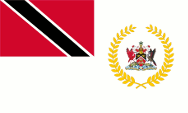
Flagge des Premierministers,
Seitenverhältnis = 3:5,
Quelle, nach: Prez001,
CC BY-SA 3.0, via Wikimedia Commons




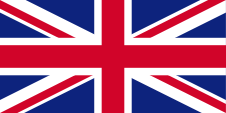
1889–1962,
Union Flag → quasi Nationalflagge,
Flagge von Großbritannien,
Seitenverhältnis = 1:2,
Quelle: Wikipedia (EN)





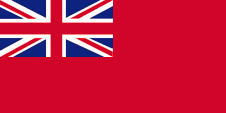
1889–1962,
Handelsflagge,
Seitenverhältnis = 1:2,
Quelle, nach: Flags of all Nations





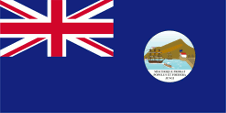
1889–1958,
Flagge der Regierung (Staatsflagge),
Seitenverhältnis = 1:2,
Quelle, nach: Flags of the World




1958–1962,
Flagge der Regierung (Staatsflagge),
Seitenverhältnis = 1:2,
Quelle, nach: Flags of the World



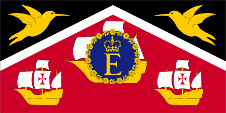
1962–1976,
Flagge der Königin,
Seitenverhältnis = 1:2,
Quelle, nach:
Flags of the World



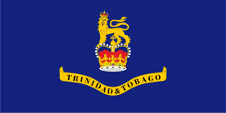
1962–1976,
Flagge des Generalgouverneurs,
Seitenverhältnis = 1:2,
Quelle, nach:
Flags of the World



Flaggen von Trinidad ← hier klicken
Flaggen von Tobago ← hier klicken

Westindische Föderation (1958–1962):
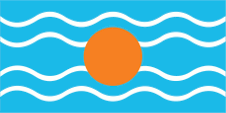
Flagge der Westindischen Föderation,
Seitenverhältnis = 1:2,
Quelle, nach: Flags of the World



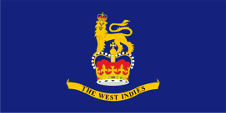
Flagge des Generalouverneurs,
Seitenverhältnis = 1:2,
Quelle, nach:
Flags of the World




Die Flagge von Trinidad und Tobago wurde am 31.08.1962 anlässlich der Unabhängigkeit angenommen und erstmals offiziell gehisst. Sie zeigt ein rotes Grundtuch mit einem weißgesäumten schwarzen Schrägbalken von links oben nach rechts unten. Die Farbe Rot symbolisiert den Mut und die Lebenskraft des Volkes, aber auch die Kraft und Wärme der Sonne. Die Farbe Weiß steht für das Wasser des Ozeans, aber auch für die Reinheit der nationalen Bestrebungen und für die Emanzipation. Schwarz ist hier die Symbolfarbe für Stärke, für die nationale Einheit, für Tatkraft, Leistungsfähigkeit und Reichtum.
Die in den meisten sorgfältigen, mehrfarbigen Reproduktionen der Flaggen von Trinidad und Tobago gezeigten Farben (teilweise auch im Wappen), lassen die Vermutung zu, dass sich Trinidad und Tobago bei den Farben und Fartönen traditionell am britischen Farbsystem orientiert, also das Farbsystem des Britischen Verteidigungsministeriums gültig ist. Das sieht vor, für Rot = Pantone 186 c, für Königsblau = Pantone 280 c und für Tiefgelb = Pantone 116 c.
Die Flagge des Präsidenten ist blau und zeigt in der Mitte das Staatswappen in Gold, umgeben von einem goldenen Kranz. Die Flagge des Premierministers ist weiß und zeigt in der Oberecke die Nationalflagge und im fliegenden Ende das Staatswappen umgeben von einem goldenen Kranz. Die ehemalige Flagge der Königin zeigte zwischen 1962 und 1976 das Bild des Wappenschildes von Trinidad und Tobago mit dem persönlichen Emblem der Königin der Mitte. Die Flagge wurde mit der Einführung der Republik abgeschafft.
In der sehr bewegten Geschichte der beiden Inseln wechselten deren Besitzer oft, und damit die hier verwendeten Flaggen. Zuletzt hatte sich Großbritannien im jahre 1803 den Besitz beider Inseln gesichert, so das ab jenem Jahr die Flagge von Großbritannien unangefochten über der Insel wehte. An Land, bis 1864 auch zur See, repräsentierten der einzelne Bürger und auch die Behörden ihren Status als Bürger oder Organe des United Kingdom, durch die Verwendung des Union Jack, "Union Flag" genannt.
Großbritannien hatte in Jahr 1864 ein Flaggensystem eingeführt, in dem:
• Kriegsschiffe einen sogenannten "White Ensign" (Marineflagge), eine weiße Flagge oft mit durchgehendem roten Georgskreuz und mit dem Union Jack in der Oberecke,
• Handelsschiffe einen "Red Ensign" (auch "Civil Ensign" → Bürgerflagge genannt, die eigentl. Handelsflagge), eine rote Flagge mit dem Union Jack in der Oberecke, und
• Dienstschiffe einen "Blue Ensign" (Regierungsflagge → die eigentliche Staatsflagge), eine blaue Flagge mit dem Union Jack in der Oberecke führten.
Seit 1865 durften Schiffe von Kolonialregierungen einen Blue Ensign mit einem Badge (Abzeichen) im fliegenden Ende verwenden. Für alle anderen Zwecke war ab diesem Zeitpunkt an Land ausschließlich der britische Union Jack zu verwenden und zur See die übliche rote britische Handelsflagge, der "Red Ensign". Wenn die britische Admiralität der Kolonie die entsprechende Erlaubnis erteilt hatte, durften Handelsschiffe und private Seeleute dieser Kolonien einen Red Ensign mit dem Bagde führen. Dies war für Trinidad und Tobago nicht der Fall. Die jeweiligen Regierungen sollten entsprechende Bagdes zur Verfügung stellen.
Ein solches Badge war oft eine auf einer Scheibe platzierte regionale landschaftliche Darstellung, zeigte oft Schiffe, historische Begebenheiten oder konnte auch nur eine Art Logo sein. Sehr oft zeigte ein Badge zusätzlich den Namen des Landes oder auch einen Wahlspruch. Einige Besitzungen hatten aber auch schon von Anfang an ein Wappen, bzw. erhielten über die Jahre eine eigenes Wappen und das Badge wurde abgeschafft. Um ein weitgehend einheitliches Erscheinungsbild im fliegenden Ende der Flaggen zu gewährleisten, wurden Wappen und auch andere Symbole auf einer weißen Scheibe in der Größe der früheren Badges dargestellt. Es gab hier aber auch Ausnahmen, denn einige Kolonien verwendeten diese weiße Scheibe nicht, und platzierten ihr Wappen oder auch nur das Wappenschild - manchmal auch vergrößert - direkt auf das Flaggentuch. Schon in den 40-er Jahren wurde dazu übergegangen die weißen Scheiben zu entfernen und das Wappen direkt zu platzieren oder vergrößert dazustellen. Dieser Umstellungsprozess erfolgte allmählich, nirgendwo gleichzeitig und vollständig. In einigen britischen Besitzungen sind bis heute Flaggen mit der weißen Scheibe in Gebrauch, in anderen nicht mehr und in einigen Gebieten gibt es beide Varianten nebeneinander.
Ab 1875 verwendete die Regierung von Trinidad, als britische Kolonie, die blaue britische Dienstflagge (Blue Ensign) mit einem Badge im wehenden Teil der Flagge. Das 1875 eingeführte Badge zeigte eine gebirgige Küstenlandschaft mit einer Küstenbefestigung. Auf der Küstenbefestigung weht eine Flagge, ein Blue Ensign. In den Küstengewässern liegt ein britisches Kriegsschiff mit gerefften Segeln auf der Reede. Im Vordergrund ist ein Ruderboot zu sehen. Der untere Teil der Scheibe zeigt das Motto der Insel auf einer weißen Fläche: "Miscerique probat populus et foedera jungi" → "Es hat sich bewährt, die Völker zu mischen und sie in Einheit zu verbinden". Im Jahre 1889 wurde Tobago der Verwaltung durch Trinidad unterstellt, das Badge wurde für Trinidad und Tobago unverändert bis 1958 beibehalten.
Gleichzeitig war die Kolonie von 1958 bis 1962 Teil der Britischen Kolonie "Westindische Föderation", ein Versuch die Verwaltung zusammenzufassen und auch den Unabhängigkeitsbestrebungen der zugehörigen Inseln und Kolonien entgegenzuwirken. Die Flagge der "Westindische Föderation" war ein hellblaues Flaggentuch mit vier waagerechten weißen Wellenlinien und einer goldenen Scheibe in der Mitte. Sie symbolisierte die Sonne über der Karibischen See. Über den Farbton des Blau ist man sich im Zweifel, es wird oft das übliche Britische Heraldikblau angenommen. Eine Zeitgenössische Beschreibung nennt jedoch ein "kaiserliches Blau" was Hellblau wäre und auch viele zeitgenössische Drucke zeigen dieses helle Blau. In diesem Zusammenhang wurde 1958 auch das Badge abgeschafft und das Bild des Badges auf einen Wappenschild übertragen und auch so auf dem "Blue Ensign", der Flagge der Regierung verwendet. Das Motto der Kolonie erschien in auf einem goldenen Spruchband unterhalb des Wappenschilds.
Quelle:
Die Welt der Flaggen,
World Statesmen,
Flags of the World,
Flaggen Wappen Hymnen,
Flaggen-Atlas Erde,
Volker Preuß

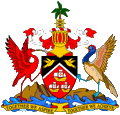
seit 1962,
Wappen von Trinidad und Tobago,
Quelle, nach: Corel Draw 4
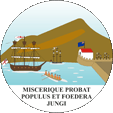
1889–1958,
Emblem von Trinidad und Tobago,
Quelle, nach: Flags of the World

1958–1962,
Emblem von Trinidad und Tobago,
Quelle, nach: Flags of the World

Das Staatswappen wurde am 09.08.1963 von Königin Elisabeth II. offiziell verliehen und wie die Flagge am 31.08.1962 anlässlich der Unabhängigkeit eingeführt. Der Wappenschild zeigt oben Schwarz und unten Rot, geteilt durch einen silbernen Sparren. Im schwarzen Feld zwei Kolibris, sie stehen für die beiden Inseln und deren Naturreichtümer. Im roten Feld drei Karavellen, es sind die Schiffe des Kolumbus. Sie stehen für das Meer welche beide Inseln trennt und verbindet. Schildhalter sind links ein Scharlach-Ibis (er repräsentiert Trinidad) und rechts ein Cocorico (er repräsentiert Tobago). Oberhalb des Schildes ein goldener Helm mit weiß-roten Decken und einem weiß-roten Wulst. Ganz oben Kleinode: ein hölzernes Steuerrad und eine Palme. Der Schild ruht auf einem Sockel, der eine Insellandschaft darstellt. Ganz unten ein goldenes Spruchband mit dem Motto des Landes: "Toghether we aspire - toghether we achieve" → "Gemeinsam bemühen wir uns – gemeinsam sind wir erfolgreich". Das 1875 eingeführte Badge zeigte eine gebirgige Küstenlandschaft mit einer Küstenbefestigung. Auf der Küstenbefestigung weht eine Flagge, ein Blue Ensign. In den Küstengewässern liegt ein britisches Kriegsschiff mit gerefften Segeln auf der Reede. Im Vordergrund ist ein Ruderboot zu sehen. Der untere Teil der Scheibe zeigt das Motto der Insel auf einer weißen Fläche: "Miscerique probat populus et foedera jungi" → "Es hat sich bewährt, die Völker zu mischen und sie in Einheit zu verbinden". Im Jahre 1889 wurde Tobago der Verwaltung durch Trinidad unterstellt, das Badge wurde für Trinidad und Tobago unverändert bis 1958 beibehalten. 1958 wurde das Badge abgeschafft und das Bild des Badges auf einen Wappenschild übertragen. Das Motto der Kolonie erschien in auf einem goldenen Spruchband unterhalb des Wappenschilds.
Quelle:
Die Welt der Flaggen,
Flags of the World,
Flaggen Wappen Hymnen,
Volker Preuß

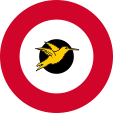
Flugzeugkokarde,
Quelle/Source, nach/by: Wikipedia (EN)

Lage:

Quelle: CIA World Factbook
Landkarte des Landes:
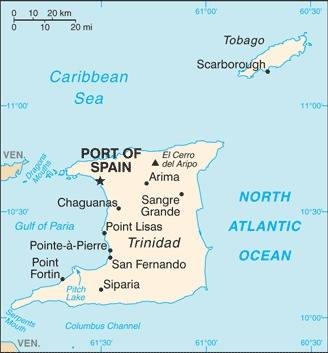
Quelle/Source: CIA World Factbook

Fläche: 5.128 km²
Einwohner: 1.500.000 (2021), davon 35% Inder und andere Asiaten, 34% Afroamerikaner, 23% gemischt, 1% Chinesen und Europäer
Religionen: 24% Katholiken, 21% Hindus, 13% Protestanten, 6% Anglikaner, 6% Baptisten, 6% Moslems, 2% Nicht-Religiöse
Bevölkerungsdichte: 293 Ew./km²
Hauptstadt: Port of Spain, 49.031 Ew. (2011)
Amtssprache: Englisch
sonstige Sprachen: Patois Creole, Spanisch
Währung: 1 Trinidad-und-Tobago-Dollar (TTD, TT$) = 100 Cents
Zeitzone: MEZ – 5 h
Quelle:
Wikipedia (DE)

Geschichte von Trinidad ← hier klicken
Geschichte von Tobago ← hier klicken
1802 · Spanien tritt Trinidad an Großbritannien ab, die Insel wird britische Kronkolonie
1803 · Tobago wird eine britische Kronkolonie
01.01.1899 · Trinidad wird mit Tobago zur Kolonie Trinidad und Tobago vereinigt
1939–1945 · Zweiter Weltkrieg, die Inseln werden zum größten alliierten Militärstützpunkt in der Karibik ausgebaut
1958–1962 · Trinidad und Tobago ist Teil der Westindischen Föderation
1959 · Großbritannien gewährt innere Selbstverwaltung
31.08.1962 · Großbritannien gewährt Unabhängigkeit im Rahmen des Commonwealth of Nations, das Land wird konstitutionelle Monarchie unter dem britischen Monarchen als Staatsoberhaupt
1970 · Unruhen
1972 · Ausnahmezustand
01.08.1976 · Trinidad und Tobago wird Republik, verbleibt jedoch im Commonwealth of Nations
1980 · Tobago erhält teilweise innere Selbstverwaltung
1987 · Tobago erhält Autonomie
Quelle:
Wikipedia (EN),
World Statesmen,
Volker Preuß

Als der spanische Seefahrer Christoph Kolumbus die Insel 1498 entdeckte, nennt er sie "Trinidad", wegen der drei eigentümlichen Bergspitzen in der Silhouette der Insel. Trinidad heißt Trinität bzw. Dreifaltigkeit.
Tobago wurde im Jahre 1498 durch den spanischen Seefahrer Christoph Kolumbus entdeckt. Er nannte sie "Bella Forma" (die Wohlgeformte), nach anderen Quellen "Isla de la Asunción" (Himmelfahrtsinsel). Nur wenige Jahre später wurde sie "Isla La Magdalena" genannt (Magdaleneninsel). Später hatte die Insel viele Namen, je nach ihrem jeweiligen Besitzer. So auch "Nieuw Walcheren" oder "Neukurland". Die Franzosen und Briten nannten sie "Tobago". Der Name geht auf das Wort Tabak zurück. Angeblich geht auch der Ursprung dieses Inselnamens auf Kolumbus zurück, weil er beobachtet hatte, dass die Kariben Tobacco-Blätter in einer Tambaku rauchten, und er habe der Insel darauf hin diesen Namen gegeben.
Quelle:
Handbuch der geographischen Namen,
World Statesmen,
etymonline.com,
Volker Preuß


![]()




























